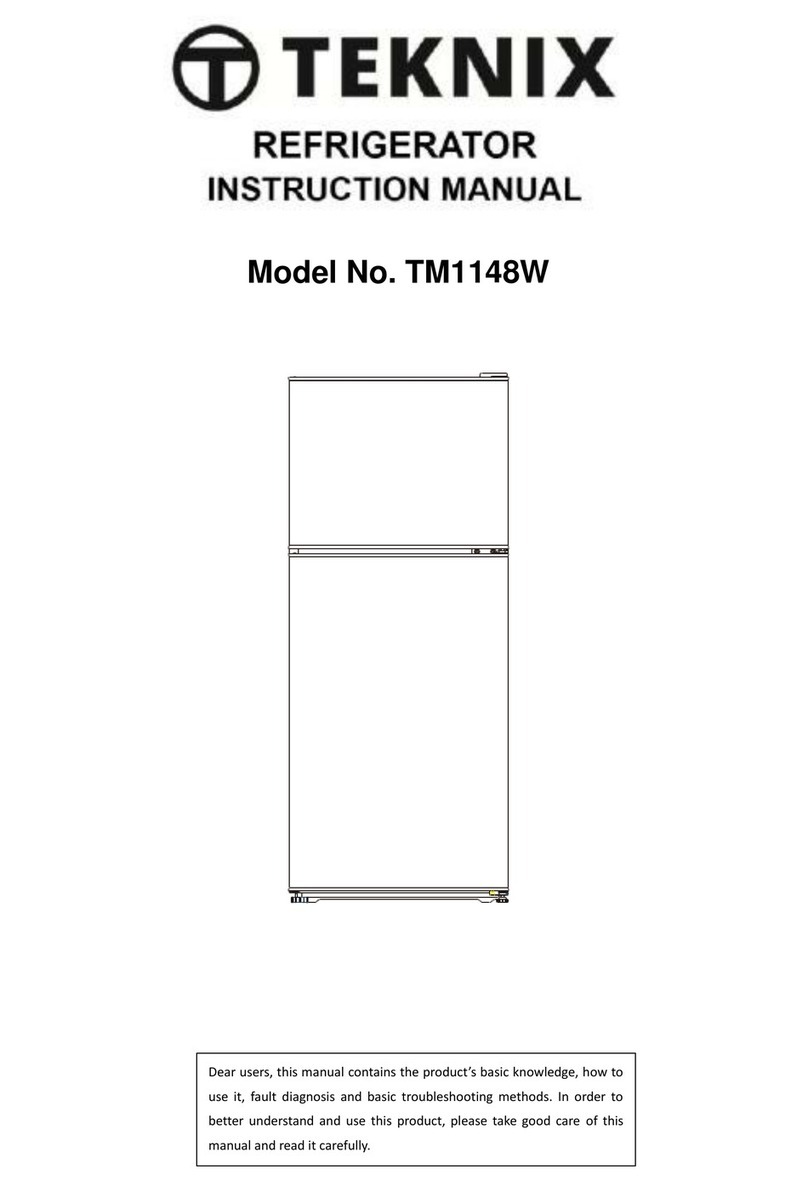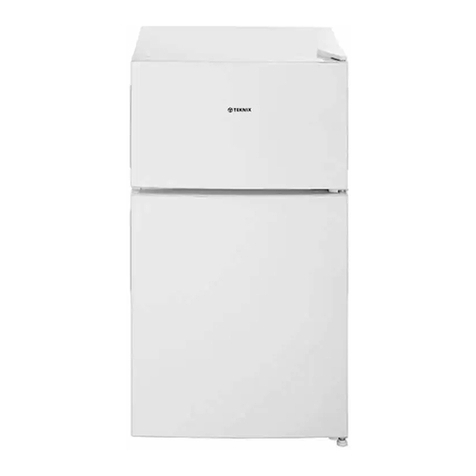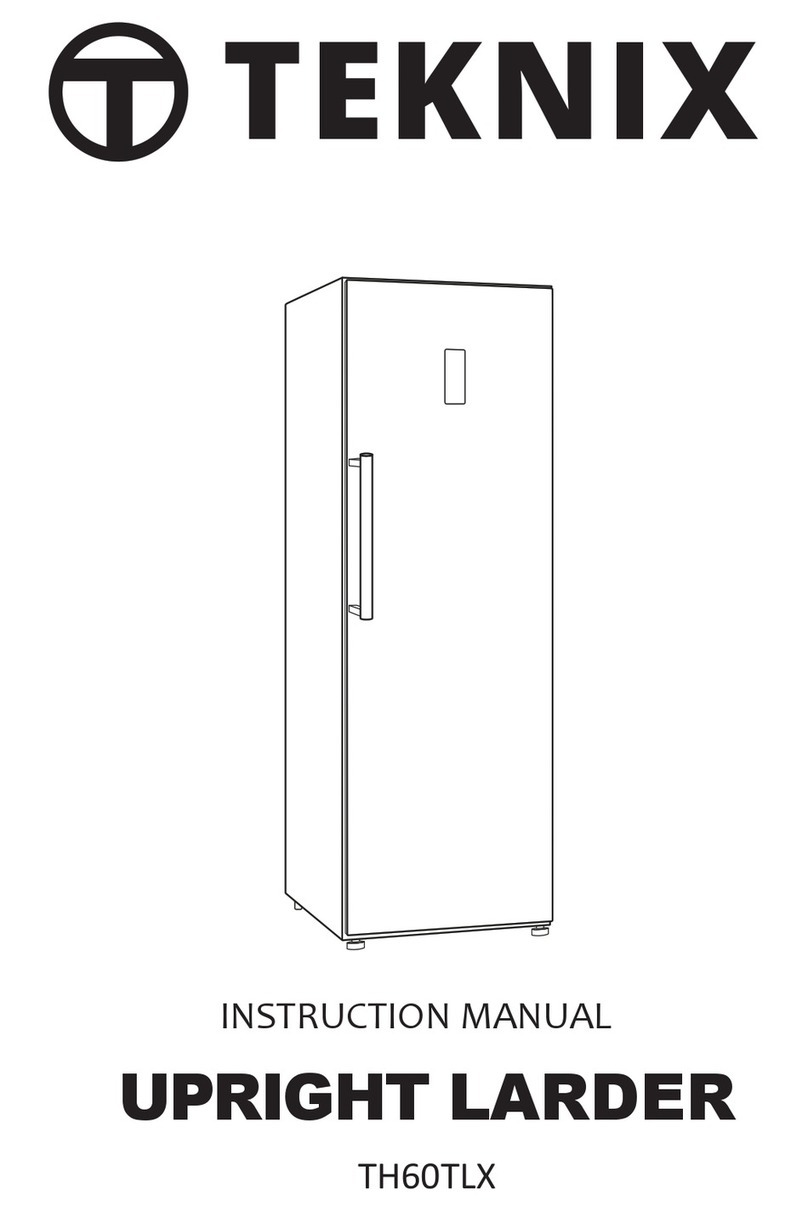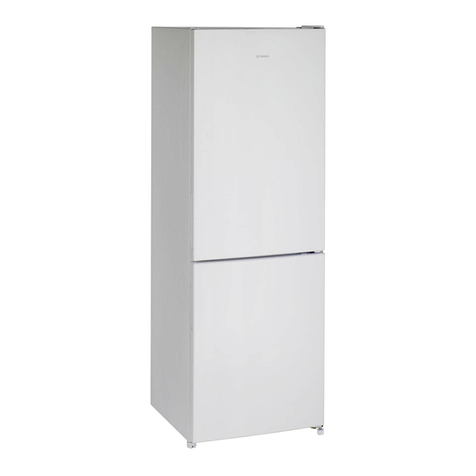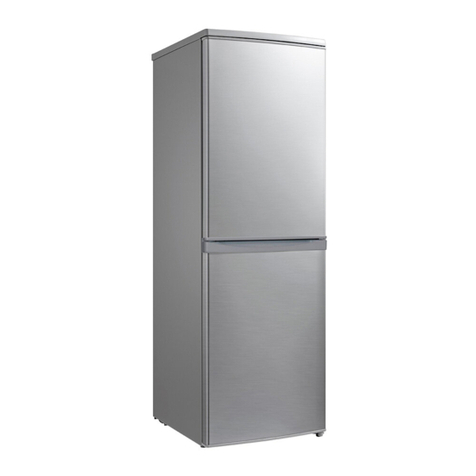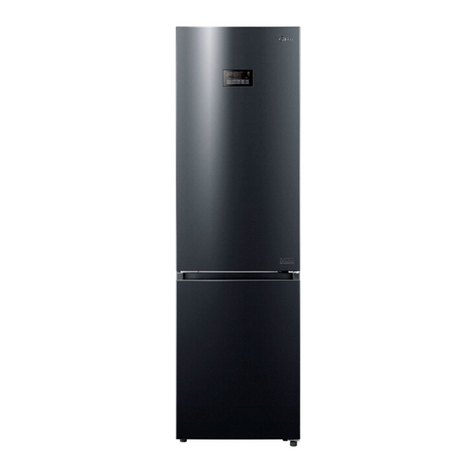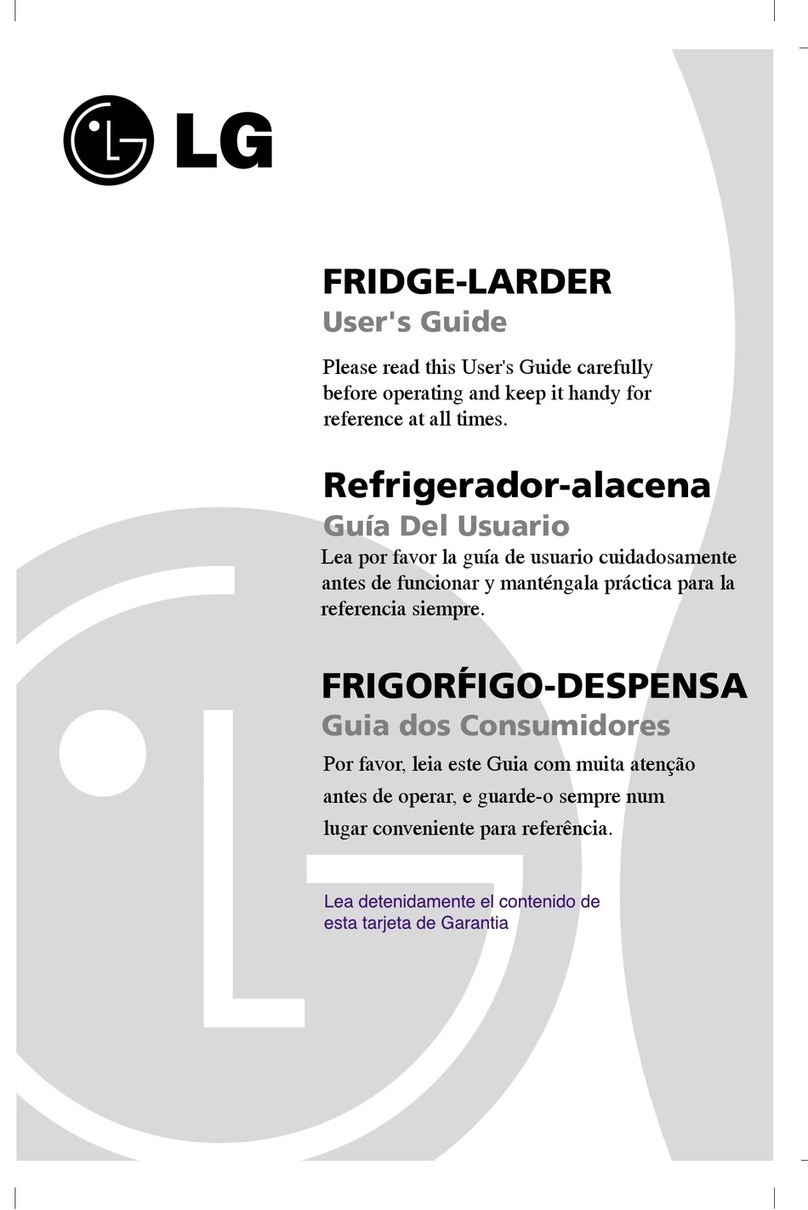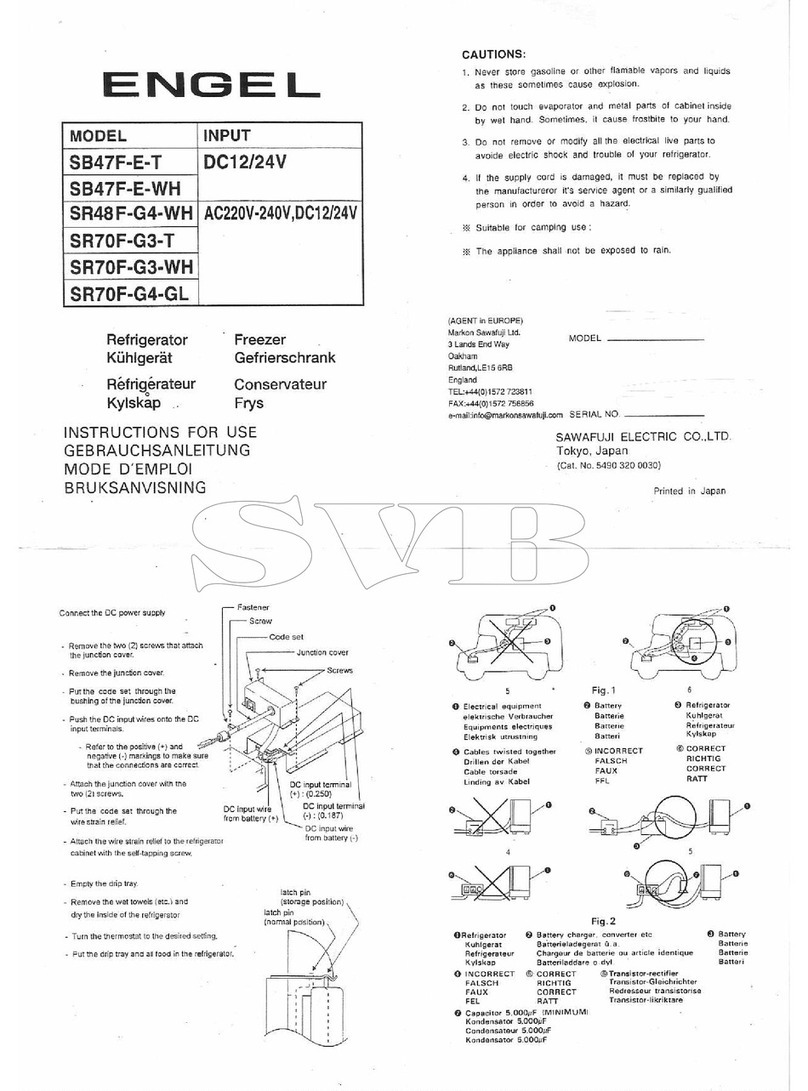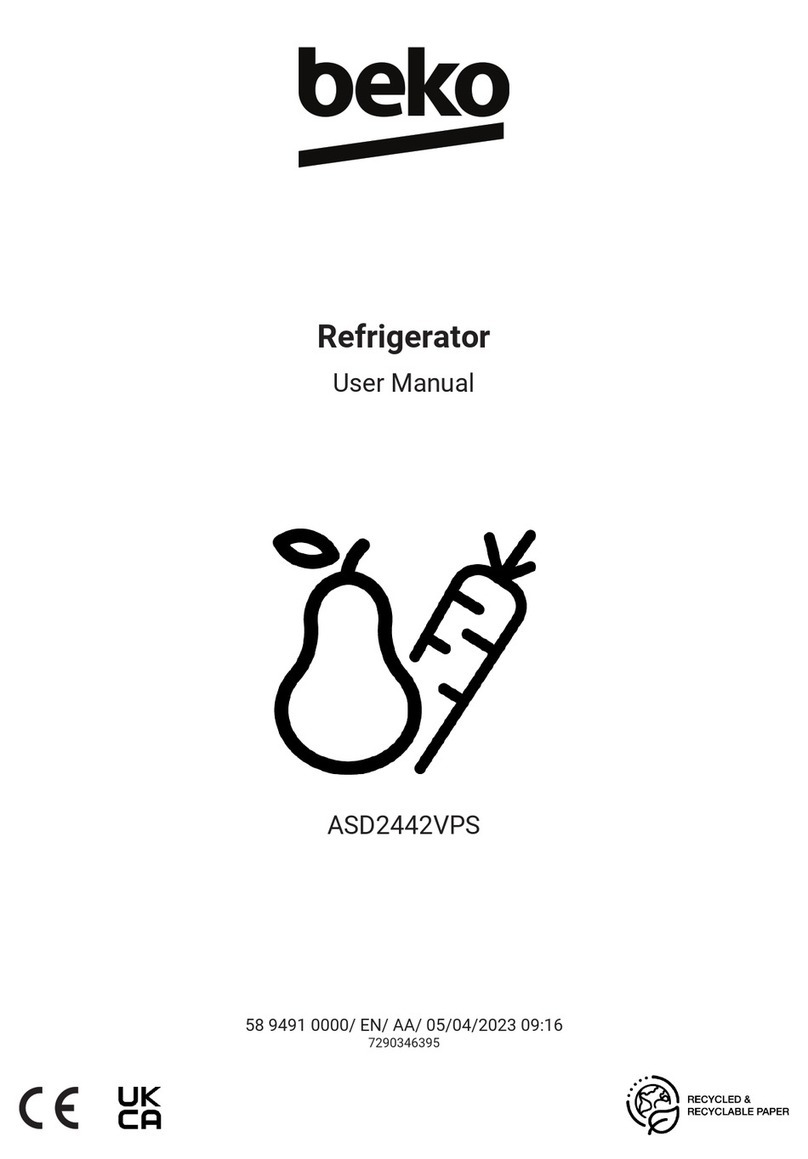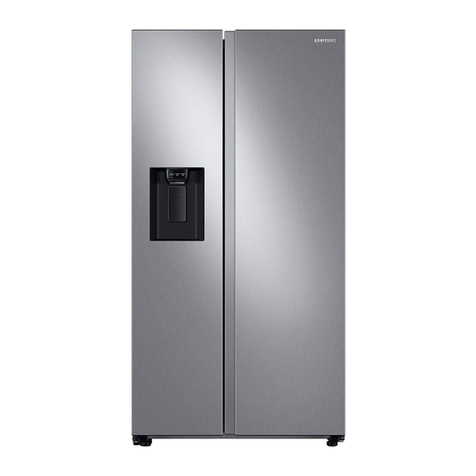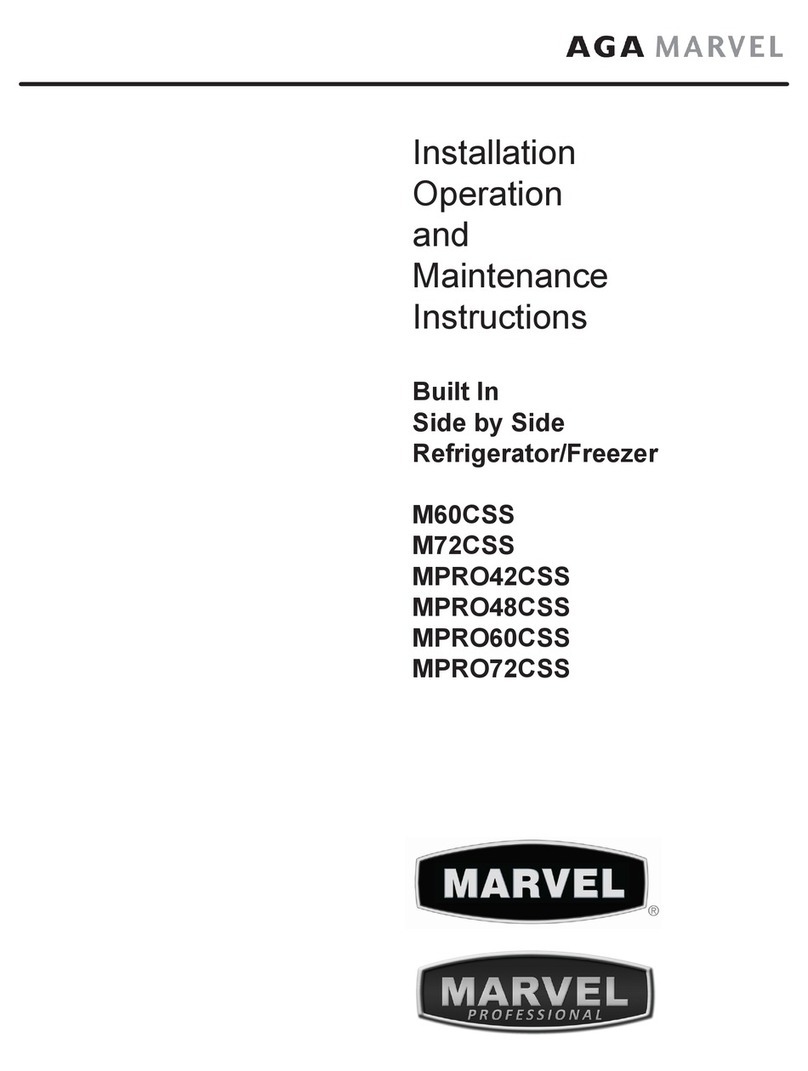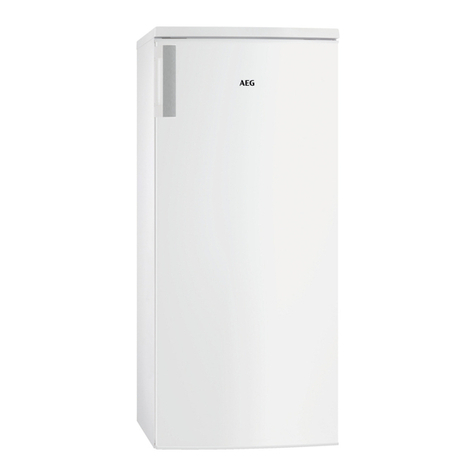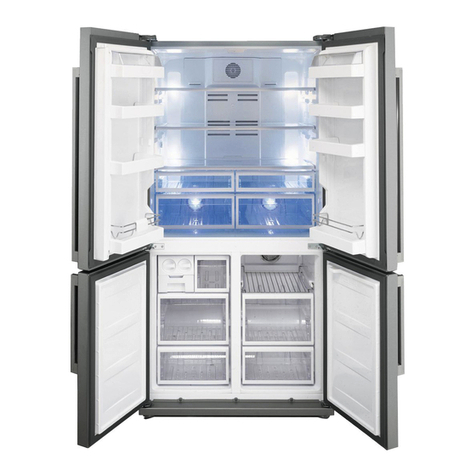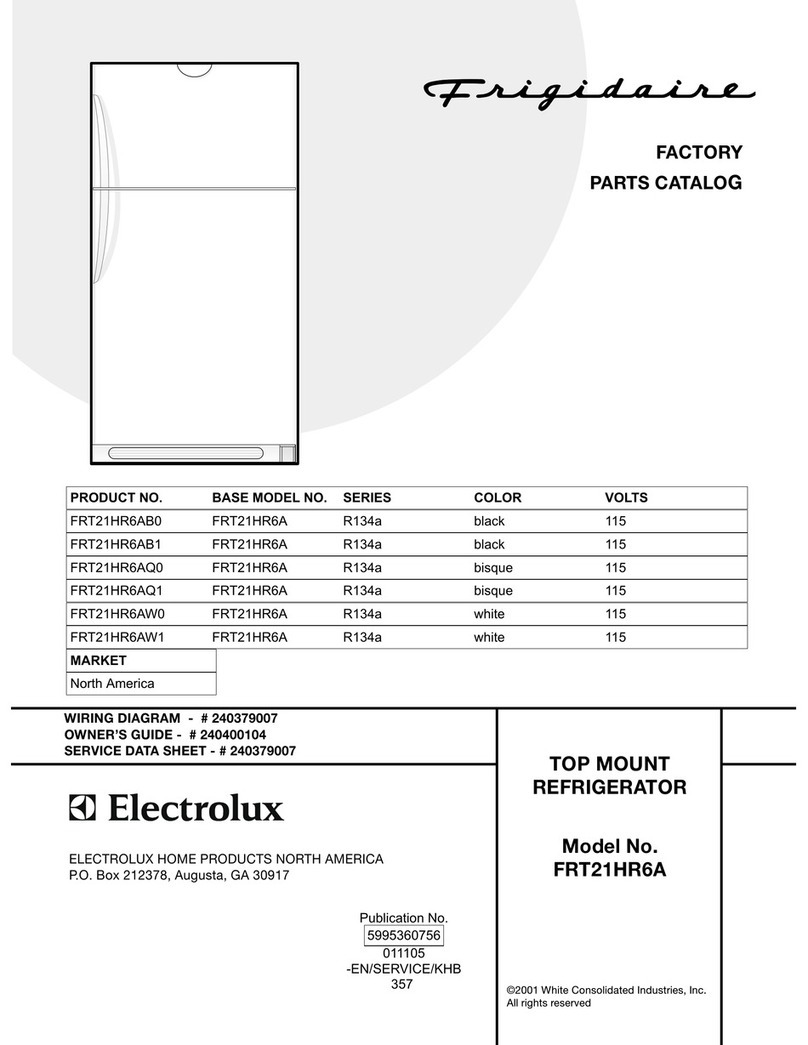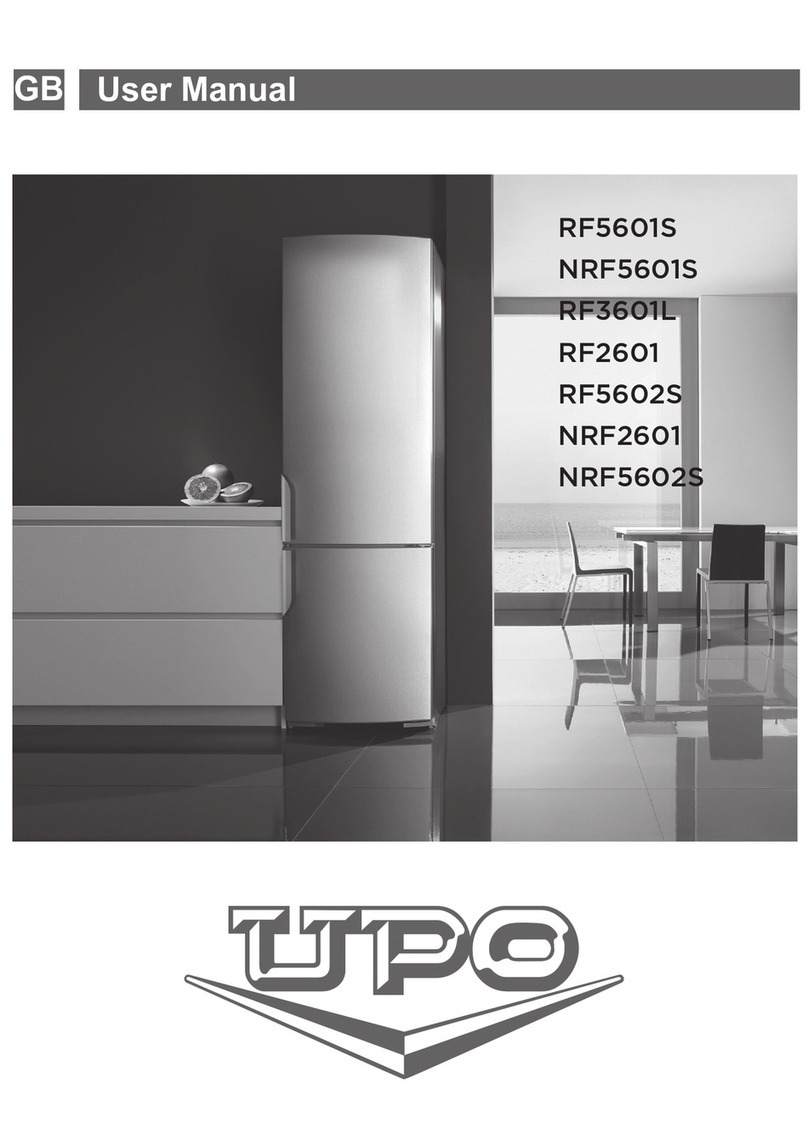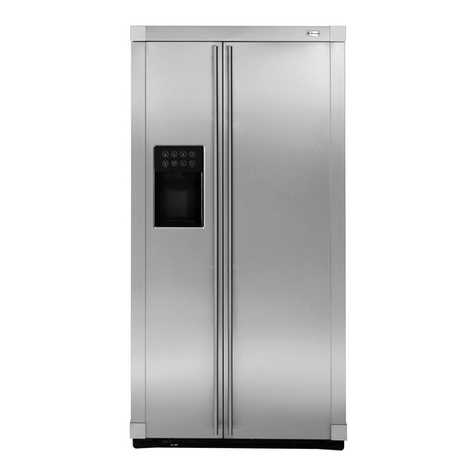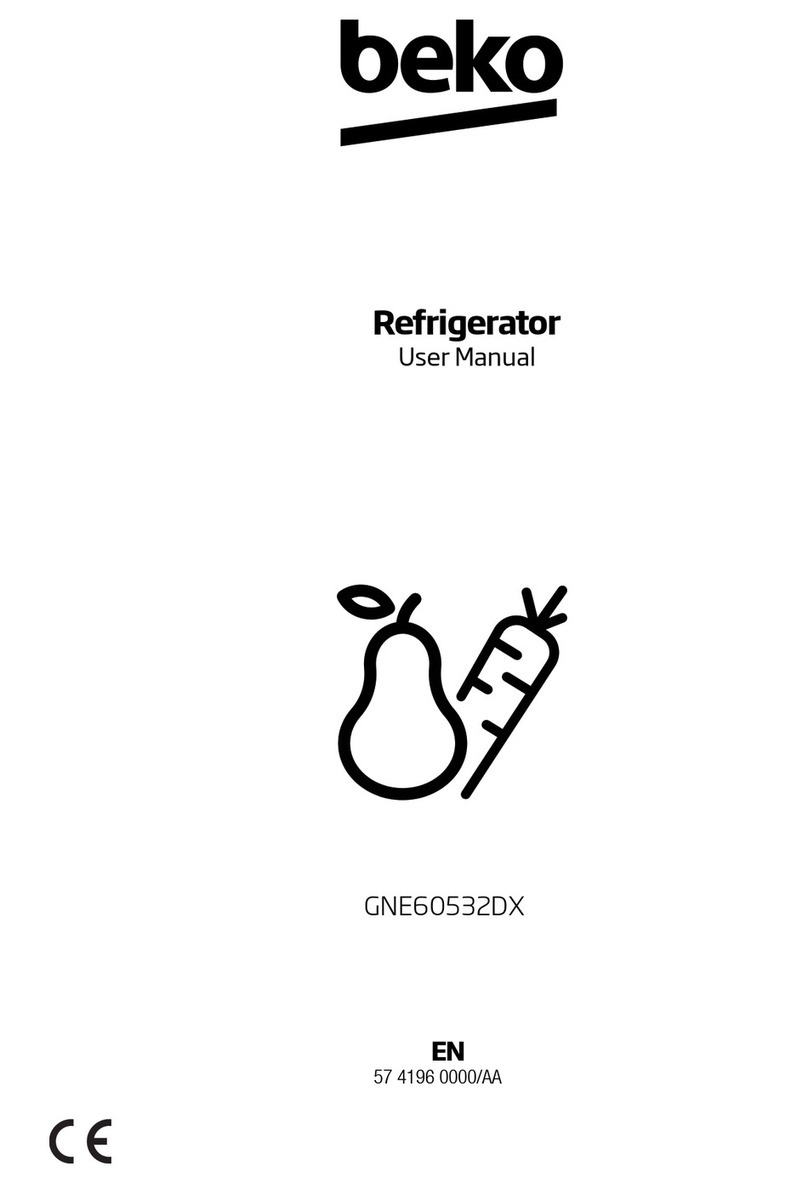TEKNIX T55L2W User manual

INSTRUCTION MANUAL
UPRIGHT LARDER
T55L2W

2
If you require any technical guidance or nd that the product is not operating as intended, please see the Troubleshooting section of this manual
Welcome
Dear users, this manual contains the product’s basic knowledge, how to use it, fault
diagnosis and basic troubleshooting methods. In order to better understand and use this
product, please take good care of this manual and read it carefully.
Help and Guidance
If you require any technical guidance or find that your product is not operating as
intended, a simple solution can often be found in the Troubleshooting section of these
instructions, or call one of our experts on 01759 487823.

3
Contents
4
8
10
12
13
16
18
20
21
22
* Varying with Different Products
I. Safety Instructions
II. Product Features
III. Preparations for Use
IV. Functions
V. Instructions For Food Storage
VI. Maintenance and Cleaning (Inc Reversing Door Swing)
VII. Troubleshooting
VIII. Certifications
IX. Product Support
X. Guarantee

4
If you require any technical guidance or nd that the product is not operating as intended, please see the Troubleshooting section of this manual
I. SAFETY INSTRUCTIONS
WARNING: It is hazardous for anyone other than authorised service personnel to
carry out servicing or repairs which involves the removal of covers. To avoid the
risk of an electric shock, do not attempt to repair this appliance yourself.
WARNING: Risk of re / ammable materials.
Safety Warnings and Information
WARNING: Do not use electrical appliances such as a hair dryer or heater to defrost your
Freezer.
WARNING: Containers with ammable gases or liquids can leak at low temperatures.
WARNING: Do not store any containers with ammable materials, such as spray cans, re
extinguisher, rell cartridges etc. in the Freezer.
WARNING: Do not place carbonated or zzy drinks in the Freezer compartment. Ice lollies
can cause “Frost/Freeze burns” if consumed straight from the Freezer.
WARNING: Do not remove items from the Freezer compartment if your hands are damp/wet,
as this could cause skin abrasions or “Frost/Freezer burns”. Bottles and cans must not be
placed in the Freezer compartment as they can burst when the contents freeze.
WARNING: Manufacturer’s recommended storage times should be adhered to. Refer to
relevant instructions.
WARNING: Do not allow children to tamper with the controls or play with the appliance.
IMPORTANT: The appliance is heavy. Care should be taken when moving it. It is dangerous
to alter the specication or attempt to modify this product in any way.
WARNING: Do not store ammable gases or liquids inside your Freezer.
IMPORTANT: If the power cable is damaged, it must be replaced by the manufacturer, its
service agent or similarly qualied persons in order to avoid a hazard.
WARNING: This appliance can be used by children aged from 8 years and above and
persons with reduced physical, sensory or mental capabilities or lack of experience and
knowledge, if they have been given supervision or instruction concerning use of the
appliance in a safe way and understand the hazards involved. Children shall not play
with the appliance. Cleaning and user maintenance shall not be made by children without
supervision.
IMPORTANT: This appliance is intended to be used in household and similar applications
such as
– staff kitchen areas in shops, ofces and other working environments,
– farm houses and by clients in hotels, motels and other residential type environments,
– bed and breakfast type environments,
– catering and similar non-retail applications.
• Keep ventilation openings, in the appliance enclosure or in the built-in structure, clear of
obstruction.
• Do not use mechanical devices or other means to accelerate the defrosting process, other
than those recommended by the manufacturer.
• Do not damage the refrigerant circuit.
• Do not use electrical appliances inside the food storage compartments of the appliance,

5
unless they are recommended by the manufacturer.
• Do not store explosive substances such as aerosol cans with a ammable propellant in
this appliance.
• This appliance is not intended for use by persons (including children) with reduced
physical, sensory or mental capabilities, or lack of experience and knowledge, unless
they have been given supervision or instruction concerning use of the appliance by a
person responsible for their safety. Children should be supervised to ensure that they do
not play with the appliance.
IMPORTANT: Keep ventilation openings in the appliance enclosure or in the built-in structure,
clear of obstruction.
WARNING: Do not use mechanical devices or other means to accelerate the defrosting
process, other than those recommended by the manufacturer.
WARNING: Do not damage the refrigerant circuit.
WARNING: Do not use electrical appliances inside the food storage compartments of the
appliance, unless they are of the type recommended by the manufacturer.
WARNING: Refrigerating appliances, in particular a refrigerator-freezer, might not operate
consistently (possibility of defrosting of contents or temperature becoming too warm in the
frozen food compartment), when appliance is running for an extended period of time, below
the cold end of the range of temperatures for which the refrigerating appliance is designed.
WARNING: It is necessary that, for doors or lids tted with locks and keys, the keys be kept
out of the reach of children and not in the vicinity of the refrigerating appliance, in order to
prevent children from being locked inside.
WARNING: The refrigerant used in your appliance and insulation materials requires special
disposal procedures.
WARNING: When positioning the appliance, ensure the supply cord is not trapped or
damaged.
WARNING: Do not locate multiple portable socket-outlets or portable power supplies at the
rear of the appliance
Children aged from 3 to 8 years are allowed to load and unload refrigerating appliances.
To avoid contamination of food, please adhere to the following instructions:
• Opening the door for long periods can cause a signicant increase of the temperature in
the compartments of the appliance.
• Clean regularly surfaces that can come in contact with food and have accessible
drainage systems.
• Clean water tanks if they have not been used for 48 hours, ush the water system
connected to a water supply if water has not been used for 5 days.
• Store raw meat and sh in suitable containers in the refrigerator, so that it is not in contact
with or drip onto other food.
• Two-star frozen food compartments are suitable for storing pre-frozen food, storing or
making ice-cream and making ice cubes.
• One, two and three-star compartments are not suitable for the freezing of fresh food.
• If the refrigerating appliance is left empty for long periods of time, switch off, defrost,
clean, dry, and leave the door open to prevent mould developing within the appliance.

6
If you require any technical guidance or nd that the product is not operating as intended, please see the Troubleshooting section of this manual
Electrical Supply Connection
• Connect the appliance to the electrical supply (220-240 V ~ 50 Hz) with the plug and
lead, which are tted.
• Connections to the mains supply should be in accordance with local regulations.
• DO NOT use plug adapter.
• The appliance must be plugged into an earthed socket
• Always make sure that the plug is accessible after the appliance has been positioned.
• If the electrical cable is damaged or worn, turn off the refrigerator and consult an
authorised agent for replacement.
Electrical Safety
WARNING: When positioning the appliance, ensure the supply cord is not
trapped or damaged.
WARNING: DO NOT locate multiple portable socket- outlets or portable power
supplies at the rear of the appliance
DO NOT use plug adapter.
WARNING: Risk of re / ammable materials
• The plug must be accessible after installation.
• The operating voltage for your appliance is 220-240 V at 50Hz.
• Connections to the mains supply should be in accordance with local regulations.
• Insert the plug into a socket with an efcient ground connection. If the socket has no
ground contact or the plug does not match, we recommend you consult a qualied
electrician for assistance.
• The appliance must be connected with a properly installed fused socket. The power
supply (AC) and voltage at the operating point must match with the details on the name
plate of the appliance (the name plate is located on the inside left of the appliance).
• The appliance must be plugged into an earthed socket.
• The plug MUST be accessible after the appliance has been positioned. The cord should
be secured and not left exposed or dangling to prevent accidental injury.
• The appliance is supplied with a standard three-pin plug, of which the one for grounding
should never be removed.
• Hold the plug, not the electrical cable, when unplugging the appliance.
• Make sure that the appliance does not trap the electric cable.
• DO NOT step on the cable.
• Avoid damage to the electric cable when moving the appliance.
• This refrigerator appliance is not designed to be used with an inverter.
DO NOT use an extension cord with this appliance. If the power cord is too short, have
a qualied electrician or service technician install an outlet near the appliance. Use of an
extension cord can negatively affect the performance of the unit.
WARNING: Improper use of the grounded plug can result in the risk of electrical shock. If the
power cord is damaged, have it replaced by an authorised service provider.

7
Climate Range
The information about the climate range of the appliance is provided on the rated plate. It
indicates at which ambient temperature (that is, the room temperature in which the appliance
is working) the operation of the appliance is optimal (proper).
Climate range Permissible ambient temperature
SN from +10°C to +32°C
N from +16°C to +32°C
ST from +16°C to +38°C
T from +16°C to +43°C
Note: Given the limit values of the ambient temperature range for the climate classes for which the refrigerating
appliance is designed, and the fact that the internal temperatures could be affected by such factors as location
of the refrigerating appliance, ambient temperature and the frequency of door opening, the setting of any
temperature control device might have to be varied to allow for these factors, if appropriate.
Freon-free
The freon-free refrigerant (R600a) and the foaming insulation material (cyclopentane) are
used for this refrigerator and are environmentally friendly, causing no damage to the ozone
layer and having very small impact on global warming. R600a is ammable, and sealed in
a refrigeration system, without leakage during normal use. In the case of refrigerant leakage
due to the refrigerant circuit being damaged, be sure to keep the appliance away from open
ames and open the windows for ventilation as quickly as possible.

8
If you require any technical guidance or nd that the product is not operating as intended, please see the Troubleshooting section of this manual
II. Product Features
This larder is equipped with manual knob controls on the inside wall of the larder. This
Larder is for the storage for fresh food storage, such as fruits, vegetables, eggs, milk and
cooked foods.
• Green technology
The freon-free refrigerant and foaming insulation materials are used for this larder,
causing no damage to the ozone layer and having a very small impact on global
warming, therefore the fridge is an environmentally friendly product.
•Reversible Doors
The doors of the larder have been designed to have the ability to be hinged from either the
right or left side. (Instructions on how to reverse the door can be found in this user manual).

9
Larder Diagram
Note: Due to technological innovation, the product descriptions in this manual may not be
completely consistent with your larder. Details are in accordance with the real product.

10
If you require any technical guidance or nd that the product is not operating as intended, please see the Troubleshooting section of this manual
III. Preparations for use
Installation location:
1. Ventilation condition
When installing your larder, ensure it is in a well ventilated location. Do not install the
larder near any heat source such as a cooker. Avoid locating the larder in direct sunlight,
this will ensure you reduce the energy consumption of the appliance. Do not locate the
larder in a damp place, this will prevent the larder from rusting and leaking electricity.
The result of the total space of the room in which the refrigerator is installed being divided
by the larder charge amount of the larder shall not be less than 8 g/ M3. Note: The
amount of refrigerant charged for the larder can be found on the nameplate.
2. Heat dissipation space
When your larder is installed and running, it will give off heat to it’s surroundings.
Therefore, a minimum of 300mm free space should be at the top of the unit, minimum of
100mm on both sides, and a minimum of 50mm at the back of the refrigerator.
Dimensions in mm:
W D H A B C(°) E F
1428 1566 1011 1107 125 50 100
Note: Figure 1, Figure 2 only illustrate the space demand of the product.
545

11
3. Level ground
Place the larder on a solid and flat ground (floor) to keep it stable, or else it will give rise
to vibration and noise.
Unobstructed ventilation shall be maintained around the appliance or in an
embedded structure.
Preparations for use
1. Standing time
After the larder is properly installed and well cleaned, do not switch it on immediately.
Make sure you allow a minimum of 4 hours before turning on the power of the larder.
2. Cleaning
Before use ensure you cleans the internal compartments and all shelves and accessories
with a soft cloth.
3. Power-on
Insert the plug into the power socket to start the compressor. After 1 hour, open the larder
door, if the temperature inside the larder compartment drops obviously, it indicates the
refrigeration system is working normally.
4. Storage of food
After the larder runs for a period of time, the internal temperature of the larder will be
automatically controlled according to the user’s temperature setting. After the larder is
fully cooled, put in foods, which usually need 2~3 hours to be fully cooled. In summer,
when the temperature is high, it takes more than 4 hours for the foods to
be fully cooled (Try to open the larder door as less as possible before the internal
temperature cools down).
If the larder is installed in a moisture filled room, make sure to check whether the ground wire
and leakage circuit breaker are normal. If vibration noises are produced due to the larder
making contact with the wall, or if the wall gets blackened by air convection around the
compressor, move the larder away from the wall. Setting up the larder may cause jamming
noise or image chaos to mobile phones, fixed-line telephone, radio receiver, television sets
surrounding it, so try to keep the refrigerator as far away as possible from these items.

12
If you require any technical guidance or nd that the product is not operating as intended, please see the Troubleshooting section of this manual
IV. Functions
The temperature of the larder is controlled by the control panel mounted inside the
larder compartment.
Temperature Selection
The temperature of the appliance can be adjusted by turning the thermostat dial.
• The thermostat can be set between 1 and 7
• 1 is the warmest setting
• 7 is the coldest setting
• The recommended setting is 3
• Set the dial to 0 to turn off the cooling function
Internal temperature of the appliance can vary based on ambient temperature, the quantity of
items stored and how frequently the door is opened.

13
V. Instructions for food storage
Precautions for use
• The appliance might not operate consistently (if there is a possibility of defrosting or
temperature becoming too warm in the frozen food compartment) when running for an
extended period of time below the cold limit of the temperature range for which the
refrigerating appliance is designed
• The information of climate type of the appliance is provided on the rating plate.
• The internal temperature could be affected by such factors as, the location of the
appliance, ambient temperature, and frequency of door being opened, etc., and if
appropriate, the setting of any temperature control device might have to be varied to
allow for these factors should be made.
• Effervescent drinks should not be stored in the freezer compartment or the low-
temperature compartment, and some products such as water ices should not be consumed
too cold.
Food storage location
Due to the cold air circulation in the refrigerator, the temperature of each area in the
refrigerator is different, so different kinds of food should be placed in different areas.
The fresh food compartment is suitable for the storage of foods that do not require to be
frozen, as well as cooked food, beer, eggs, some condiments that need cold preservation,
milk, fruit juice, etc. The crisper box is suitable for the preservation of vegetables, fruits, etc.
Use of the fresh food compartment
Set the temperature of the fresh food storage compartment between 2ºC & 8ºC , and store
the foods that are intended for short-term storage, or to be eaten at any time in the fresh
food compartment.
Fridge shelf: When removing the shelf, lift it up first, and then pull it out; and when
installing the shelf, place it into position before putting it down. Keep the shelf rear flange
upward, to prevent foods from contact of fridge wall. When taking out or putting in the
shelf, hold it firmly, and handle with care to avoid damage.
Crisper box: Pull out the crisper box for access to food. After using or cleaning the
cover plate of the crisper box, be sure to put it back onto the crisper, so that the internal
temperature of the crisper box will not be affected.
Cautions for food storage
Before foods are put in the refrigerator, it is advisable to seal them, to prevent water
evaporation. Keep fresh fruits and vegetables on one section, this will help to prevent taint
of odor in other sections of the refrigerator.
Do not over crowd the refrigerator. Keep enough space between foods because if foods
are too close, the cold air flow will be blocked, thus affecting the refrigeration effect. Do not
store excessive or overweight foods, to avoid the shelf from being crushed. When storing
the foods, keep a distance away from the inner wall; and do not place the water-rich foods
too close to the fridge rear wall, as there will be a risk of them becoming frozen to the inner
wall.

14
If you require any technical guidance or nd that the product is not operating as intended, please see the Troubleshooting section of this manual
Categorised storage of foods
Foods should be stored by category, with the foods you eat every day placed in front of the
shelf, so that the door open duration can be shortened and food spoilage due to expiration
can be avoided.
Energy-saving tips: Allow hot food to cool down to the room temperature before putting it in
the refrigerator. Put the frozen food in the fresh food compartment to thaw, using the low
temperature of the frozen food to cool the fresh food, thus saving energy.
Tips for Fridge Storage.
•Allow the hot foods to cool down to the room temperature before putting them in the
larder.
•To avoid contamination and odour transfer, foods should be packed and/or covered by
suitable materials. Eg firm, tasteless, impervious to air and water, non-toxic and
pollution-free.
•Leave space between foods in the larder to ensure suitable cool air flow around food
products.

15
Moving your Larder/Fridge/Freezer
• Location
Do not place your larder near a heat source, e.g. cooker, boiler or radiator. Avoid it from
direct sunlight in out-buildings or sun lounges.
• Leveling
Make sure to level your larder using the front leveling feet. If not level, the larder door
gasket and sealing performance will be affected, or it may lead to the operating failure of
your larder.
After locating the larder in position, wait for 4 hours before using it, to allow the
refrigerant to settle.
• Installation
Do not cover or block the vents or grills of your appliance.
NOTE:
•If the appliance will not be used for several months, turn it off first, and then unplug the
plug from the wall outlet.
•Take out all food.
•Clean and dry the interior thoroughly. To prevent odor and mold growth, leave the door
ajar.
•Keep the cleaned appliance in a dry, ventilated place and away from the heat source,
and do not place heavy objects on top of it.
• The unit should not be accessible to children’s play.
Vacation Time
•Turn off the larder first and then unplug the unit from the wall outlet.
•Remove all the food.
•Clean the larder .
•Leave the lid open slightly to avoid possible formation of condensation, mold, or
odors.
•Use extreme caution in the case of children. The unit should not be accessible to
child’s play.
•Short vacations: Leave the refrigerator operating during vacations of less than three
weeks.
•Long vacations: If the appliance will not be used for several months, remove all food
and unplug the power cord. Clean and dry the interior thoroughly. To prevent odor
and mold growth, leave the door open slightly: blocking it open if necessary or have the
door removed.

16
If you require any technical guidance or nd that the product is not operating as intended, please see the Troubleshooting section of this manual
VI. Maintenance and cleaning
Before cleaning, turn off power rst then unplug the appliance from the wall socket.
Do not plug in or pull plug out with wet hands, because there is a risk of electric shock
and injury.
Do not spill water directly on the larder, to avoid rust, electricity leakage and
accidents.
Do not stretch your hands into the bottom of the larder, you might be scratched by
sharp metal corners.
Internal Cleaning and External Cleaning
The food residuals in the larder are liable to produce bad odor, so the larder must be
cleaned regularly.
The fresh food compartment should be cleaned once a month.
Remove all shelves, crisper box, bottle racks, cover board, and drawers etc, and clean them
with a soft towel or sponge dipped in warm water or neutral detergent.
Clear off the dusts accumulated on the rear panel and side plates of the larder often. After
using detergent, be sure to rinse it with clean water, and then wipe it dry.
Do not use bristle brushes, steel wire brushes, detergent, soap powder, alkaline
detergent, benzene, gasoline, acid, hot water and other corrosive or soluble items to
clean the cabinet surface, door gasket, plastic decorative parts, etc, to avoid damage.
•Try to open the larder door as less as possible, to ensure food safety and food is kept
fresh for hours even in the hot summer.
•If you get the power outage notice in advance:
1) Adjust the thermostat knob to the high mode an hour in advance, so that foods get fully
frozen (Do not store new food during this time!). Restore the temperature mode to the
original setting when power supply becomes normal in a timely manner.
2) Once the larder is powered on and in use, it is best to use the larder continuously
under normal circumstances to ensure not to affect the service life of the appliance.
Servicing
This product should be serviced by an authorised engineer and only genuine spare parts
should be used.
Under no circumstances should you attempt to repair the appliance yourself.
Repairs carried out by inexperienced persons may cause injury or serious malfunctioning.
Contact your after sales support team for assistance.

Defrosting
After a period of use, a thin layer of frost will be formed on the larder compartment inner wall
(or evaporator) surface, which may affect the refrigeration performance if exceeding 5mm in
thickness. In such case, you need to gently scrape the frost off using an ice scraper rather than
the metal or sharp object. Frost needs to be cleared off every 3 months, or if the frost is affecting
the normal use of the drawers and or the refrigeration performance. Use the following steps to
remove frost:
1. Take out chilled foods, shut off the mains power supply, open the larder door, and gently
remove the frost from the inner wall with an ice scraper. To speed up the thawing process,
it is suggested to place a bowl of hot water inside the larder, and when the solid ice
particles become loose, use an ice scraper to remove from surface.
2. After defrosting, clean the larder inside, and switch on the power supply.
17
If you require any technical guidance or nd that the product is not operating as intended, please see the Troubleshooting section of this manual
Changing the internal lamp
Before carrying out the bulb replacement always press and turn the thermostat control to
dial to position “OFF”, then disconnecting the mains supply.
•Hold and lift up the light bulb cover.
•Remove the old bulb by unscrewing it in an anti-clockwise direction.
•Replace with a new bulb (10W) by screwing it in a clockwise direction marking sure
that it is secure in the bulb holder.
•Refit the light cover and re-connect your Fridge/Freezer to the mains supply and
switch on.

18
If you require any technical guidance or nd that the product is not operating as intended, please see the Troubleshooting section of this manual
VII. Trouble Shooting
With regard to the following small faults, not every failure needs to be xed by the technical
service personnel; you can try to solve the problem by referring to table below.
CASE INSPECTION SOLUTIONS
Completely non- refrigeration • Is power plug off?
• Are breakers and fuses
broken?
• No electricity or line trip?
• Re-plug
• Opening the door and
checking whether the lamp
is lit.
Abnormal noise • Is refrigerator stable?
• Does refrigerator make
contact with the wall?
• Adjusting refrigerator's
leveling feet.
• Move appliances further
away from the wall.
Poor refrigerating efciency • Do you put hot food or too
much food in the fridge?
• Do you open the door
frequently?
• Is the fridge in direct sunlight
or near a furnace or stove?
• Is it well-ventilated?
• Temperature setting in too
high?
• Putting food into refrigerator
when hot food reached room
temperature.
• Checking and closing the
door.
• Relocate the refrigerator away
from heat source.
• Relocate fridge to location
which has good ventilation.
• Change setting to an
appropriate temperature.
Peculiar smell in refrigerator • Any spoiled food?
• Do you need to clean
refrigerator?
• Have you packed food of
strong avors?
• Throw away spoiled food.
• Clean refrigerator.
(Recommended regularly)
• Seal foods of strong avors.
NOTE: Condensation may appear on the outside of the larder when there is change in room
temperature. Wipe off any residue of moisture. If this problem continues contact your after sales
support team.

19
Note: If the trouble shooting advice does not resolve your problem, do not attempt
to dissemble or repair this appliance. Repairs carried out by an inexperienced
person may cause injury or serious malfunctioning. Contact your after sales service
provider. This product should be serviced by an authorised engineer with only
genuine spare parts.
When the appliance is not in use for long periods, disconnect from the electricity
supply, empty all foods and clean the appliance, leaving the door ajar to prevent
unpleasant smells and mould.

20
If you require any technical guidance or nd that the product is not operating as intended, please see the Troubleshooting section of this manual
VIII. Certications
Electrical information
This electrical appliance must be grounded.
This product is equipped with a plug, which is suitable for all houses equipped with sockets
meeting the current specications.
If the tted plug is not suitable for your socket outlets, it should be cut off and carefully
disposed of by a qualied electrician. To avoid a possible shock hazard, do not insert the
discarded plug into a socket.
This product complies the EEC directives.
Table of contents
Other TEKNIX Refrigerator manuals
